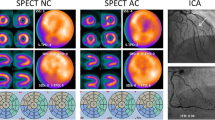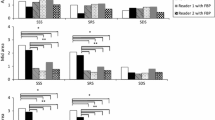Abstract
Purpose
High-speed (HS) single-photon emission computed tomography (SPECT) with a recently developed solid-state camera shows comparable myocardial perfusion abnormalities to those seen in conventional SPECT. We aimed to compare HS and conventional SPECT images from multiple centres with coronary angiographic findings.
Methods
The study included 50 patients who had sequential conventional SPECT and HS SPECT myocardial perfusion studies and coronary angiography within 3 months. Stress and rest perfusion images were visually analysed and scored semiquantitatively using a 17-segment model by two experienced blinded readers. Global and coronary territorial summed stress scores (SSS) and summed rest scores (SRS) were calculated. Global SSS ≥3 or coronary territorial SSS ≥2 was considered abnormal. In addition the total perfusion deficit (TPD) was automatically derived. TPD >5 % and coronary territorial TPD ≥3 % were defined as abnormal. Coronary angiograms were analysed for site and severity of coronary stenosis; ≥50 % was considered significant.
Results
Of the 50 patients, 13 (26 %) had no stenosis, 22 (44 %) had single-vessel disease, 6 (12 %) had double-vessel disease and 9 (18 %) had triple-vessel disease. There was a good linear correlation between the visual global SSS and SRS (Spearman’s ρ 0.897 and 0.866, respectively; p < 0.001). In relation to coronary angiography, the sensitivities, specificities and accuracies of HS SPECT and conventional SPECT by visual assessment were 92 % (35/38), 83 % (10/12) and 90 % (45/50) vs. 84 % (32/38), 50 % (6/12) and 76 % (38/50), respectively (p < 0.001). The sensitivities, specificities and accuracies of HS SPECT and conventional SPECT in relation to automated TPD assessment were 89 % (31/35), 57 % (8/14) and 80 % (39/49) vs. 86 % (31/36), 77 % (10/13) and 84 % (41/49), respectively.
Conclusion
HS SPECT allows fast acquisition of myocardial perfusion images that correlate well with angiographic findings with overall accuracy by visual assessment better than conventional SPECT. Further assessment in a larger patient population may be needed to confirm this observation.





Similar content being viewed by others
References
Klocke FJ, Baird MG, Lorell BH, Bateman TM, Messer JV, Berman DS, et al. ACC/AHA/ASNC guidelines for the clinical use of cardiac radionuclide imaging--executive summary: a report of the American College of Cardiology/American Heart Association Task Force on Practice Guidelines (ACC/AHA/ASNC Committee to Revise the 1995 Guidelines for the Clinical Use of Cardiac Radionuclide Imaging). Circulation. 2003;108:1404–18.
Loong CY, Anagnostopoulos C. The diagnosis of coronary artery disease by radionuclide myocardial perfusion imaging (meta-analysis). Heart. 2004;90 Suppl V:V2–9.
Reyes Y, Anagnostopoulos C. Risk assessment by myocardial perfusion imaging in patients with suspected or known stable coronary artery disease. Nucl Med Commun. 2003;25:217–20.
Garcia EV, Faber TL, Esteves FP. Cardiac dedicated ultrafast SPECT cameras: new designs and clinical implications. J Nucl Med. 2011;52:210–7.
Sharir T, Ben-Haim S, Merzon K, Prochorov V, Dickman D, Ben-Haim S, et al. High-speed myocardial perfusion imaging. Initial comparison with conventional dual detector anger camera imaging. J Am Coll Cardiol Cardiovasc Imaging. 2008;1(2):156–63.
Erlandsson K, Kacperski K, van Gramberg D, Hutton BF. Performance evaluation of D-SPECT: a novel SPECT system for nuclear cardiology. Phys Med Biol. 2009;54:2635–49.
Nakazato R, Tamarappoo BK, Kang X, Wolak A, Kite F, Hayes SW, et al. Quantitative upright-supine high speed SPECT myocardial perfusion imaging for detection of coronary artery disease: correlation with invasive coronary angiography. J Nucl Med. 2010;51(11):1724–31.
Patton J, Slomka P, Germano G, Berman D. Recent technological advances in nuclear cardiology. J Nucl Cardiol. 2007;14:501–13.
Sharir T, Slomka PJ, Hayes SW, DiCarli MF, Ziffer JA, Martin WH, et al. Multicentre trial of high-speed versus conventional single-photon emission computed tomography imaging. Quantitative results of myocardial perfusion and left ventricular function. J Am Coll Cardiol. 2010;55:1965–74.
Shepp LA, Vardi Y. Maximum likelihood reconstruction for emission tomography. IEEE Trans Med Imaging. 1982;1:113–22.
Lange K, Carson R. EM reconstruction algorithms for emission and transmission tomography. J Comput Assist Tomogr. 1984;8:306–16.
Hudson HM, Larkin RS. Accelerated image reconstruction using ordered subsets of projection data. Trans Med Imaging. 1994;13:601–19.
Nishina H, Slomka PJ, Abidov A, Yoda S, Akincioglu C, Kang X, et al. Combined supine and prone quantitative myocardial perfusion SPECT: method development and clinical validation in patients with no known coronary artery disease. J Nucl Med. 2006;47:51–8.
Matzer I, Kiat H, Friedman JD, Van Train K, Maddahi J, Berman DS. A new approach to the assessment of tomographic thallium-201 scintigraphy in patients with left bundle branch block. J Am Coll Cardiol. 1991;17:1309–17.
Marcassa C, Campini R, Zoccarato O, Calza P. Wide beam reconstruction for half-dose or half-time cardiac gated SPECT acquisitions: optimization of resources and reduction in radiation exposure. Eur J Nucl Med Mol Imaging. 2011;38:499–508.
Valenta I, Trreyer V, Husmann L, Gaemperli O, Schindler MJ, Herzog BA, et al. New reconstruction algorithm allows shortened acquisition time for myocardial perfusion SPECT. Eur J Nucl Med Mol Imaging. 2010;37(4):750–7.
Bateman TM, Heller GV, McGhie AI, Courter SA, Golub RA, Case JA, et al. Multicenter investigation comparing a highly efficient half-time stress-only attenuation correction approach against standard rest-stress Tc-99m SPECT imaging. J Nucl Cardiol. 2009;16(5):726–35.
Bocher M, Blevis IM, Tuskerman L, Shrem Y, Kovalski G, Volokh L. A fast cardiac gamma camera with dynamic SPECT capabilities: design, system validation and future potential. Eur J Nucl Med Mol Imaging. 2010;37:1887–902.
Ben-Haim S, Baavour R, Haroon A, Allie R, Sitek A, Scouler A, et al. Assessment of myocardial perfusion reserve with dynamic myocardial perfusion SPECT (abstract). J Nucl Med. 2011;52:384.
Ben-Haim S, Kacperski K, Hain S, Gramber DV, Hutton BF, Waddington WA, et al. Simultaneous dual-radionuclide myocardial perfusion imaging with a solid-state dedicated cardiac camera. Eur J Nucl Med Mol Imaging. 2010;37:1710–21.
Fiechter M, Ghadri JR, Kuest SM, Pazhenkottile AP, Wolfrum M, Nkoulou RN, et al. Nuclear myocardial perfusion imaging with a novel cadmium-zinc-telluride detector SPECT/CT device: first validation versus invasive coronary angiography. Eur J Nucl Med Mol Imaging. 2011;38(11):2025–30.
Duvall WL, Sweeny JM, Croft LB, Barghash MH, Kulkarni NK, Guma KA, et al. Comparison of high efficiency CZT SPECT MPI to coronary angiography. J Nucl Cardiol. 2011;18:595–604.
Duvall WL, Sweeny JM, Croft LB, Ginsberg E, Guma KA, Henzlova MJ. Reduced stress dose with rapid acquisition CZT SPECT MPI in a non-obese clinical population: comparison to coronary angiography. J Nucl Cardiol. 2012;19:19–27.
Gimelli A, Bottai M, Giorgetti A, Genovesi D, Kusch A, Ripoli A, et al. Comparison between ultrafast and standard single-photon emission CT in patients with coronary artery disease. A pilot study. Circ Cardiovasc Imaging. 2011;4:51–8.
Gimelli A, Bottai M, Giorgetti A, Di Martino F, Marzullo P. High diagnostic accuracy of low-dose gated SPECT with solid-state ultrafast detectors: preliminary clinical results. Eur J Nucl Med Mol Imaging. 2012;39(1):83–90.
Acknowledgment
This work was undertaken at UCLH/UCL which received a proportion of funding from the Department of Health’s NIHR Biomedical Research Centres funding scheme.
Conflicts of interest
Drs. Tali Sharir, William H. Martin and Simona Ben-Haim are consultants for Spectrum-Dynamics. Dr. Daniel Berman owns shares in Spectrum-Dynamics and is a member of the Medical Advisory Board and consultant for Spectrum-Dynamics. Dr Jack A. Ziffer has equity in Spectrum-Dynamics. Dalia Shiti is employed by Spectrum-Dynamics.
Author information
Authors and Affiliations
Corresponding author
Rights and permissions
About this article
Cite this article
Neill, J., Prvulovich, E.M., Fish, M.B. et al. Initial multicentre experience of high-speed myocardial perfusion imaging: comparison between high-speed and conventional single-photon emission computed tomography with angiographic validation. Eur J Nucl Med Mol Imaging 40, 1084–1094 (2013). https://doi.org/10.1007/s00259-013-2399-6
Received:
Accepted:
Published:
Issue Date:
DOI: https://doi.org/10.1007/s00259-013-2399-6




